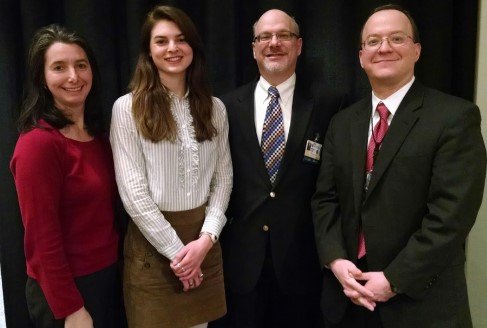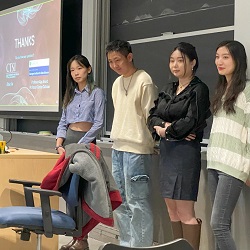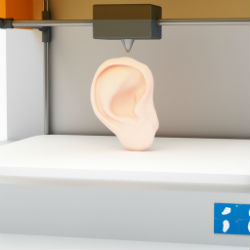Meet the winner of the 3rd Annual “America’s Got Regulatory Science Talent” competition
by Samreen Jatana
Special to CTSI Stories
Angela Ryck is the winner of the University of Rochester’s 3rd Annual America’s Got Regulatory Science Talent Student Competition Winner. She spoke with CTSI Stories about her project.
Could you tell me a little bit about your background and what got you interested in the competition?
I went to the University of Notre Dame for my undergraduate studies and I majored in Science Business, which was one of the pre-med tracks. In 2013, I went to Washington D.C. to do my Masters in Public Health at George Washington University (GW). Last July, I came to the University of Rochester to do another Masters degree in Biomedical Engineering through the CMTI program (Center for Medical Technology and Innovation). One of the requirements of the program is that we take the Pathways to Medical Innovation course, which is taught by Joan Adamo, Ph.D., who organizes this competition along with Scott Steele, Ph.D. It is through the Pathways class that I became familiar with the competition. We had to actively think about a Regulatory Science topic throughout the semester and come up with an innovative idea to address a particular problem.
What was the format of the competition? Could you discuss the structure of it?
They did not give us any strict guidelines to follow, which was great. But the basis was that the FDA set up eight priority areas in 2011 specifying the issues that they really want to address. For the competition we had to choose one priority area and devise a solution to address it. We were not required to write a proposal or perform any sort of study for this purpose; it was quite open-ended in terms of how we could choose to present our ideas. The competition was open to teams or individuals, and I chose to work independently. We had just five minutes to present our ideas to the three judges.
Which priority area did you focus on? Could you talk about the ideas you presented in your talk?
I addressed FDA’s 7th priority area, which is focused on enhancing medical counter measures, referred to as MCMs. Broadly speaking, these are the tools that we use to address situations including chemical threats or food that is contaminated or not safe. Within that area I focused on enhancing emergency communication, which I geared specifically towards food safety. To enhance emergency communications, the FDA wants to first assess past communications to see specifically where improvements are needed. My idea was a sort of two-fold system that improves on the present while also assessing past communications; I called it the “ESCAPE” System. This is an acronym for “Emergency Situation Communication and Preparedness Evaluation”. To enhance current communications, it involves a universal card (the ESCAPE Card) that could be used at a wide range of stores or restaurants when a person buys food. That card will be linked to their contact information such as phone number or email. That way, in the event of a recall, those who purchased the recalled item can receive direct notification such as a text or phone call.
Stores like Wegmans and Costco are already doing exactly this, but it is not yet widespread or used by restaurants. Often people receive news of a recall via TV news or Internet, but this could make it more personalized and thus more effective. This will not only allow faster communication but will relieve people from anxiety if they were not involved in a certain recall case. Aside from this, people will still need an incentive to participate. Discounts and rewards systems tied to participating stores and restaurants could serve that purpose; and in return those stores and restaurants could retain some customer loyalty and perhaps some useful marketing information.
For the second aspect of assessing past communications, I designed a community-level evaluation to be used across the country. It would be a short series of questions answered online and part of the activation process when users first receive their ESCAPE card. The data collected could help the FDA to get a sense of how people in different geographical areas have received and/or understood past communications, and could also help to identify trends in health literacy. I was interested in this because of a previous experience of mine. During my masters in public health at GW, I interned for the Center for Disease Control & Prevention (CDC) in the State of Maine. I traveled throughout the State of Maine to conduct Rural Active Living Assessments, which look at individual communities and their capacity to promote physical activity through their facilities and programs. Getting down to the community level is important because it shows how the strengths and needs of communities can differ greatly. I applied this experience to the area of emergency communication. Furthermore, Diana Monaco, a public affairs specialist at the FDA is a regional representative at the Buffalo office, and speaking with her was very helpful as well.

What next?
In the spring of 2016, I will travel to Maryland with Joan Adamo and Scott Steele and I will get an opportunity to present my project to the FDA. Before that I will continue to research and keep up with the news on this topic to ensure that all aspects of my proposal are in line with the goals of the FDA. Specifically, I’d like to further develop the evaluation portion of ESCAPE.
How does this competition fit into your future career goals? Do you see yourself working for the FDA at some point?
I definitely plan to work within the medical field. This competition and proposal are both in line with that. I really enjoyed this experience because it is so pertinent to what I learned during my public health degree and also very relevant to biomedical engineering. For example, you cannot design a medical device without familiarity with the FDA and the regulatory procedures. I learned a lot about the FDA during this project even though food safety is a little bit different than medical devices. Still, the ESCAPE Card concept could be applicable to medical devices as well. The idea can definitely be expanded to improve upon communication in a wide range of areas.
Michael Hazard | 1/22/2016



